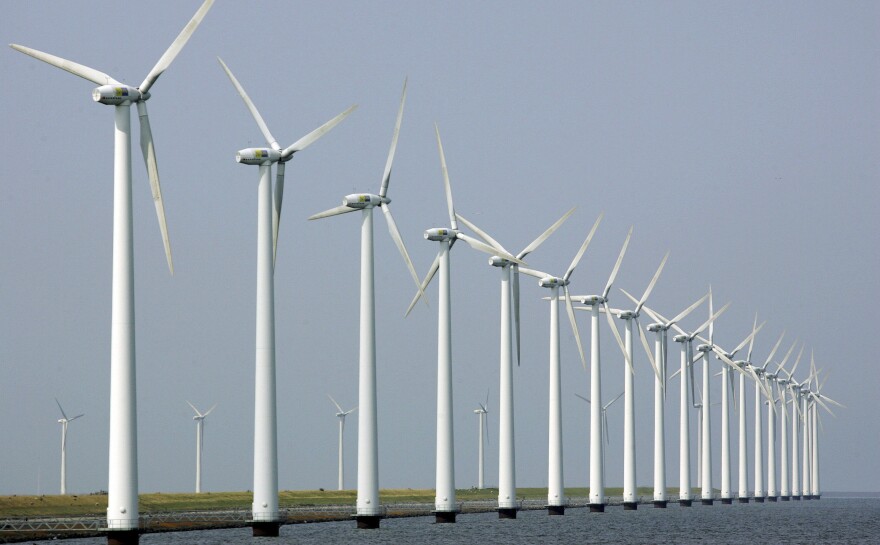New York’s first offshore wind farm off the coast of Long Island has been granted federal approval. The South Fork project could be a model for future clean energy plans around the country.
“This just demonstrates there is a workable process now — there’s obviously complexity to this project, and obviously federal agencies have to weigh in — what it shows is there’s good alignment now in the federal government to support this new industry,” said Ken Bowes, the vice president for offshore sites and permits at Eversource.
The federal Bureau of Ocean Energy Management issued a favorable “record of decision” last week for the South Fork Wind project off the coast of the Hamptons. Officials said this will help the state reach its clean energy goals.
“On the state level it demonstrates that this is the first permitted offshore wind farm in New York and it shows that there's a process going forward that will be repeated,” said Bowes, “and many other offshore wind farms will develop in the future because of this process.”
State officials said the project will be a critical milestone for New York in reaching its clean energy goals.
“Our nation-leading climate and offshore wind goals demand bold action and moving South Fork Wind forward brings us closer to a cleaner and greener future,” Governor Kathy Hochul said in a statement.
Bowes said there has also been overwhelming approval from East Hampton to expand their green energy resources. Twelve wind turbines 35 miles off short Montauk Point will deliver power through a transmission cable to the regional electric grid.
“The town of East Hampton, the local requirements, have a goal to be 100% clean energy for their community and this goes a long way to satisfying that need as well,” said Bowes.
Despite this approval, a handful of opponents are working to block the project.
In November, lawsuits were filed on behalf of Hamptons ratepayers against the Long Island Power Authority.
Attorney Cameron Macdonald, executive director of the Government Justice Center, which is representing the ratepayers, said LIPA ignored its own criteria for power production resources by entering into a contract for this wind farm.
“State law provides that any sort of [government] procurement of goods or services, including the Long Island Power Authority, must go through a competitive bidding process and your bids when they come in must be, but must be responsive to the request for proposal and be the best economic terms,” Macdonald said. “It's not clear whether the price was lowest, but certainly the bid response from Deepwater Wind was not responsive.”
Eversource is in a development partnership with Orsted, the Danish parent company to the offshore wind giant, Deepwater Wind.
Macdonald said that LIPA’s original request was looking for ways to handle peak electric electricity demand in the Hamptons, especially during the summer months when typically demand is high in the vacation hotspot. “A place that has an expansive population in the summer, in the hot hours of the day, people turn on the air conditioning and run their pool pumps that can put a demand on the grid,” he said.
“They asked for something that would not require new transmission facilities, and could be turned on and off as required to meet the demand,” Macdonald said. “How did it pick a wind project with turbines 35 miles offshore that require a 60 mile undersea cable and connection points on land and transmission on land? And its wind power that cannot be just turned on and off on demand.”
The lawsuit also claims the project's power is unreliable because it depends on an intermittent resource to generate electricity. Climate scientists have said the waters off New York and in New England are prime locations for offshore wind. The problem relates more to how that renewable energy is stored in batteries. LIPA said that technology is not readily available and expensive.
“The South Fork Wind project is a leading example of the state’s clean energy transition and will benefit all Long Island customers,” a LIPA spokesperson said. “The evaluation of this project took all technical considerations into account, including those described in the report, as well as the environmental benefits of offshore wind.”
LIPA said it is seeking a proposal for a battery storage project, with plans to procure 400 megawatts of battery storage through 2030 — three times the power the wind project can generate.
But until then, Macdonald said ratepayers will have to shoulder those costs.
At Eversource, Bowes said as with any big construction project they anticipated backlash, and they'll see how this plays out in court. But he is confident with the lengthy state processes of approving this project and said the contract will survive any legal challenges.
The South Fork Wind project is expected to begin construction next month. It will create thousands of union jobs and power over 70,000 New York homes by the end of 2023.



